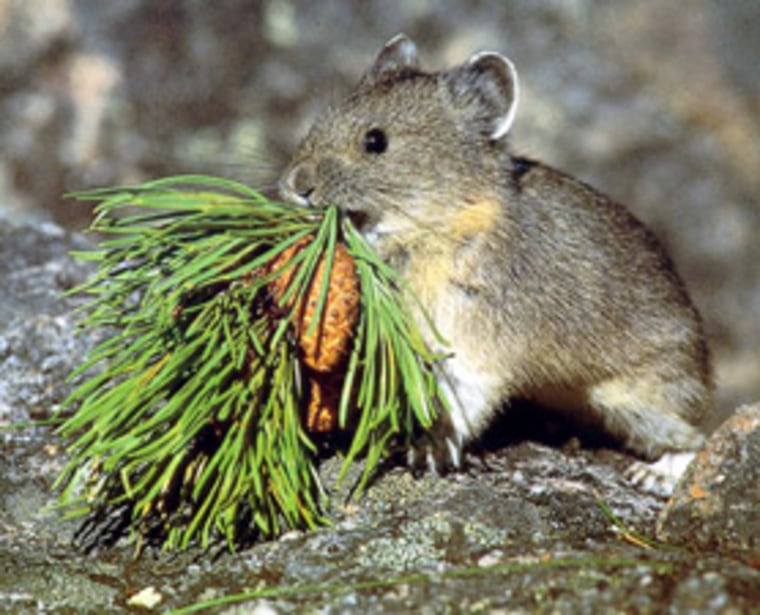In what may be some rare good news amid global warming, the mountain-dwelling American pika, which some predicted might be one of climate change's first casualties, is thriving in the Sierra Nevada mountains, according to a new study.
The study also finds that pikas prefer a particular type of rock formation, and that the temperatures inside these formations are surprisingly cooler than the outside air. This may offer pikas a refuge from warming temperatures.
Meanwhile, other recent research shows that pikas are disappearing from sites in the Great Basin in the American West, where chronically warm temperatures appear to be to blame. And reduced snowpack is stripping them of their wintertime blankets of snow, beneath which they store their food and stay insulated from harsh cold and huge temperature swings during winter.
Pikas, tiny relatives of the rabbit, live in rock piles in the mountains and are well adapted for cold weather. Experiments with caged pikas from the 1970s showed that the creatures cannot survive without a way to escape the heat in temperatures above 78-85 degrees Fahrenheit.
Studies of pika habitat in the Great Basin published in 2003 found that some warmer, drier sites that pikas occupied earlier in the 20th century were now empty of pikas. This type of evidence led some researchers to project that pikas would be squeezed off the top of mountain habitats as warm temperatures crept upwards.
The authors of the new survey of pika habitat, published in Arctic, Antarctic and Alpine Research say their results show that pikas can handle a wider range of temperatures and lower elevations than researchers have observed.
"We feel that the Sierra populations are thriving," said study lead author Constance Millar of the U.S. Department of Agriculture Forest Service in Albany, Calif. "Part of the reason for that seems to be that they have an enormous amount of continuous, high quality habitat."
Rock fields formed by the freezing and thawing of exposed rock on steep slopes form the best pika habitat. This freeze-thaw process generates beach-ball-sized rocks with deep caverns between them.
"Basically, wherever you can find these landforms, there are pika," Millar said.
By measuring the temperature inside these formations and in the surrounding air, Millar determined that the interior temperature is much cooler than the outside temperature.
"I think the take home message from her work is that the species isn't going to heck in a hand basket all over the place," said Erik Beever, a wildlife ecologist who has studied pikas for the last 16 years and who has tracked the changes in pika populations in the Great Basin. "It's doing better in some places than in others,"
Andrew Smith of Arizona State University, who has studied pikas since the late 1960s, agrees.
"I think that what's going to come out is that picas are remarkably flexible," Smith said. They can adjust what times of day they are active depending on the daytime temperatures, much like people living in Phoenix versus Anchorage. When temperatures are hottest, they will restrict their activities to dawn and dusk, for instance.
Beever has also found that pikas are doing well in the Sierra Nevada. But elsewhere, climate may be exacerbating the difficulty of living in already-marginal habitat. His research shows pikas are disappearing from sites in the Great Basin. These sites are generally hotter and drier than those in the Sierra Nevada.
But climate does seem to play a role in the pika's changing prevalence in these areas. "If you want the story from the Great Basin, the story made real simple is that climate is the single strongest factor involved in changing the distribution," Beever said. But he stresses that other factors appear to act together with climate to contribute to local extinctions.
In his most recent study of pikas, published in Ecological Applications, Beever found that the strongest predictor of pikas disappearing from a site was not the number of days that the temperature inside their rock piles was above the heat tolerance threshold. Rather, pikas were most likely to be lost from sites with the hottest temperature throughout the summer.
These studies follow an early February decision by the U.S. Fish and Wildlife Service rejecting a petition to list the American pika as an endangered species.
"(Millar's study) doesn't change how I see the issue of pika endangerment by climate change," said biologist Shaye Wolf of the Center for Biological Diversity in San Francisco, one of the organizations that brought the petition and subsequent lawsuits calling for the pika listing.
But according to Smith, it was the right decision not to list the pika: "There are things that are truly endangered (by climate change). There are butterflies and birds that should warrant attention, rather than a species that really isn't being driven to extinction by climate change."
